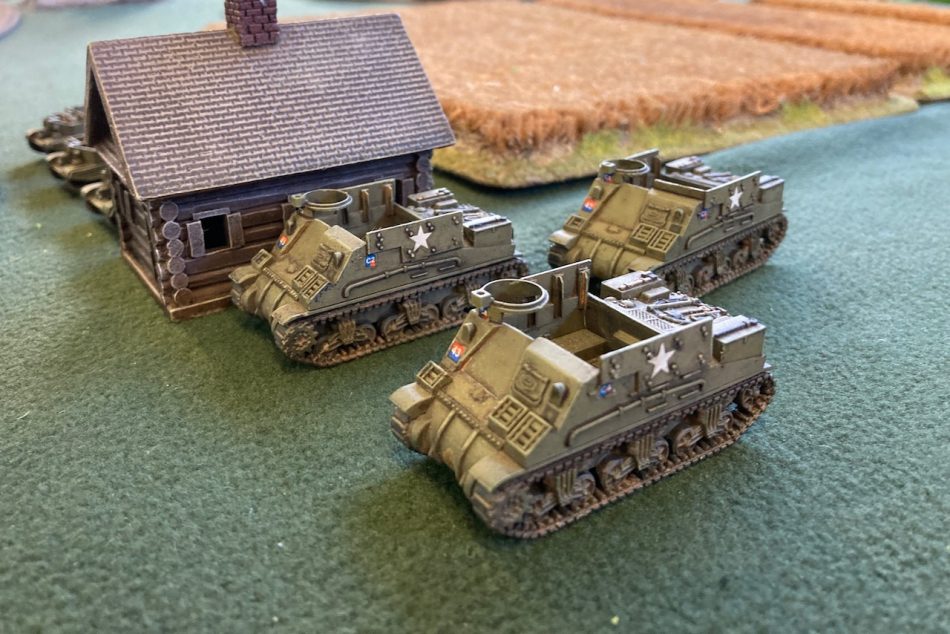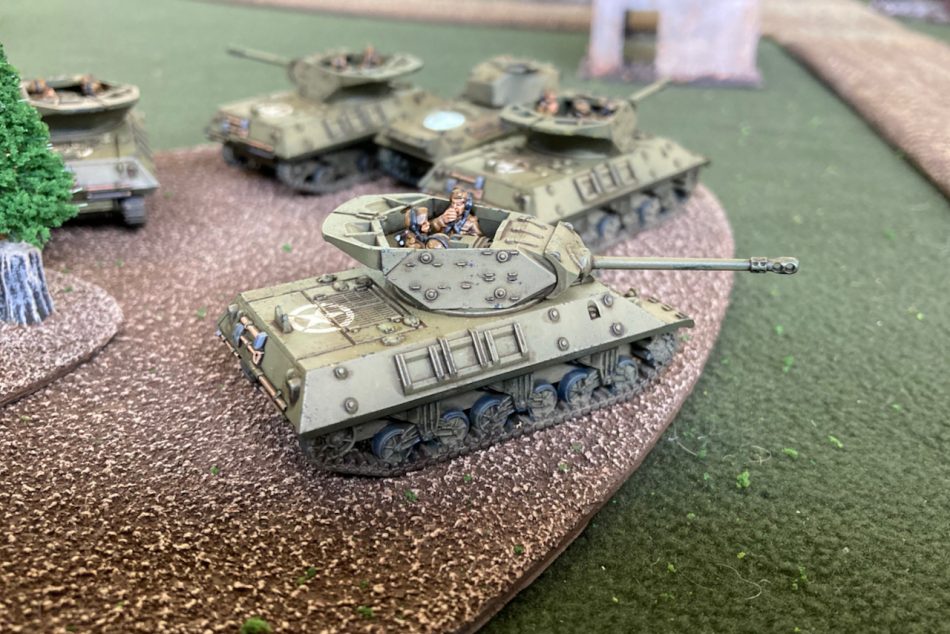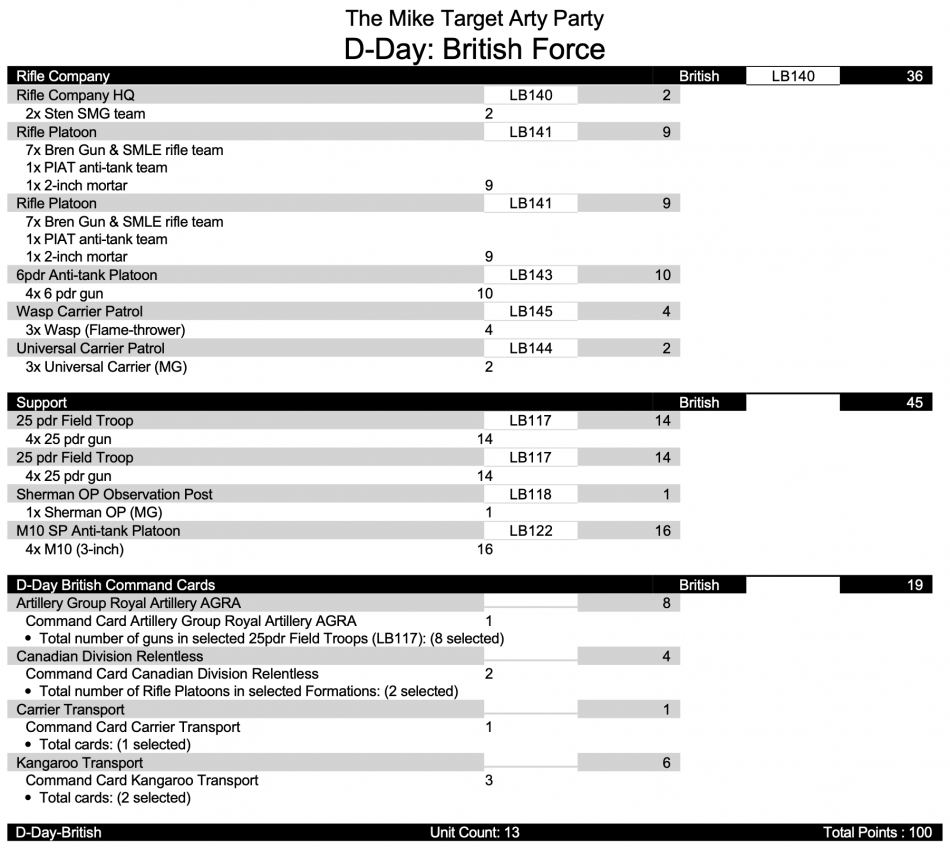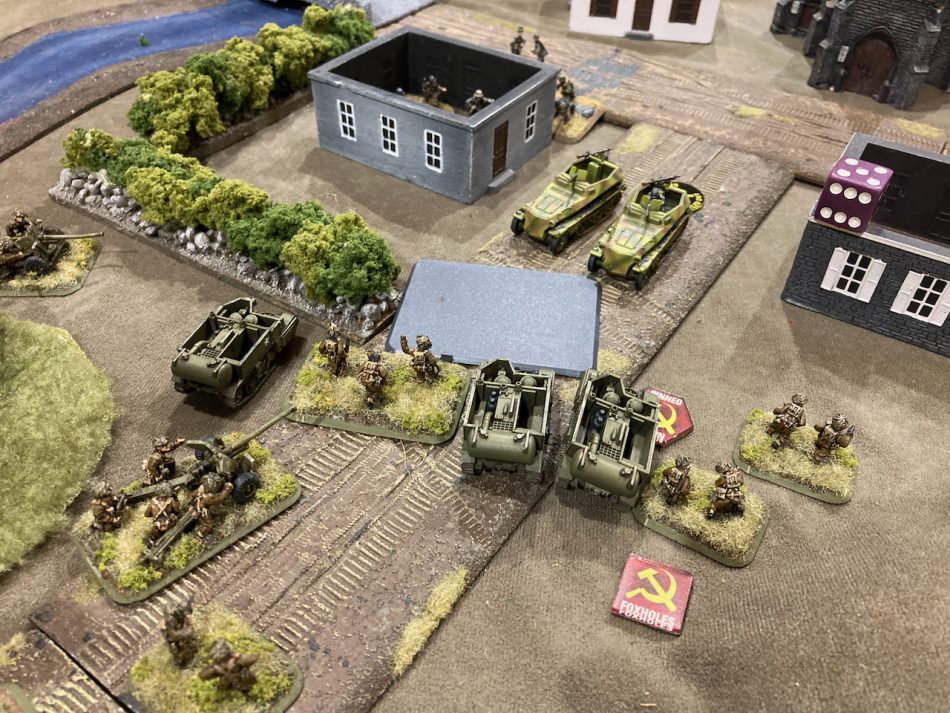Mike Target – An Exercise in List Building for Flames of War
By Richard Steer
“Does anyone have any Wespes that I can borrow?” The request was posted by a friend on one of our local group chats ahead of a Late-War Flames of War tournament last year. Once the accusations of “meta chasing” died down, it led to a conversation about the role and effectiveness of artillery in the game.
As someone who primarily plays British forces, my contribution to the discussion was that while the Late-War British lists have a lot of artillery options, only mortars and AVREs offer good value. The British towed artillery piece, the 25pdr, is only Firepower 4+ and is expensive due to being Fearless Veteran. Where the Germans and Americans have cost-effective three-gun units of self-propelled artillery, the British Priest and Sexton troops are units of four, again being Fearless Veteran.
To cap it off, it’s not easy to make use of that Veteran skill because most British Formation Commanders are only rated as Trained. Almost everything that the 25pdr should be able to do in the game can be done more effectively by Crocodiles.
The 25pdr field gun played an immense role in British and Commonwealth actions throughout the war, and it’s a shame that they don’t see the table more often. To do my bit to help correct this, I challenged myself to build a British list that goes all-in on artillery.

The British Artillery Special Rules
Mike Target is a British special rule that makes it easier to run two artillery units in your force. Normally when a spotting team ranges in an artillery bombardment, it can then use the next of its three ranging attempts to attempt to range in another bombardment. Mike Target changes that by reusing the same ranging attempt instead of the next one.
There’s another special rule lurking in the British Command Card deck: AGRA. This card, named after the Army Group Royal Artillery formations that supported British and Canadian corps, increases the Firepower of the 25pdr to 3+ on Repeat Bombardments for 1 point per gun, but only for Repeat Bombardments, and only if you are the Attacker. According to a ruling in Lessons from the Front, since the card changes the rating of a unit, it cannot be left out of battle if you end up defending and unable to use it. It’s a bad card, so, of course, I had to use it.
To use both Mike Target and AGRA, you need to run an artillery-centered Rifle Company, and always choose to attack. The kind of list that does that in 100pts would look quite different from what is popularly seen as a good British build.

The Core of the Build
The force has to be built around a Rifle Company, two 25pdr troops, and the AGRA card. It makes sense to add a Sherman OP, to take advantage of the guns’ Veteran skill.
The biggest problem that Late-War British infantry will face when attacking is their Rally 5+. There are a few ways around this:
- One of the command cards that specifically boost Rally, such as Relentless or Bagpipes.
- Kangaroo Transports, because the only way to pin passengers in armored transports is to destroy one of the vehicles.
- Night Attack in the missions where it’s allowed, to make everything harder to hit for the first few turns.
Looking at those three in combination, it suddenly becomes clear what the rules are combining to incentivize: a Canadian or Scottish Rifle Company making a night attack in Kangaroos while supported by stacks of artillery. This sounds a lot like Operation Totalize.

Filling Out the List
The first issue that must be addressed is the Crocodile. This is a potent unit at a great price, and always one of the first support units to consider for a British force, but it does not fit well with this particular list. Night Attack prevents units outside the Formation from leaving the Attacker’s deployment zone until Dawn Breaks, so the Crocodiles may be unable to support the infantry until turn 5 or 6, which may be too late.
With Crocodiles out of the picture, what am I looking for? I need as many of my units as possible to be from within the Rifle Company Formation to avoid restricting myself with the Night rules.
Universal Carriers. Having a cheap Spearhead is crucial in a number of missions, and they are useful for closing off potential ambush sites without weakening your attack.
Wasp Carriers. Pinning the Defender’s units prior to assaulting them is a problem at night, as Night stacks with Concealment to make the defender much harder to hit. Wasp flamethrowers only need a single hit to pin, so are an excellent backup plan.
6-pounder anti-tank guns. While the list is supposed to attack, there will be some situations where this can’t happen. I need to be prepared to play against armored lists in a Meeting Engagement, or to defend against some matchups, and the 25pdrs’ Anti-tank 9 isn’t quite enough for the tanks you most commonly see in Late-War. If required, I can use the 6pdrs aggressively by adding the Carrier Transport Command Card, and bringing the guns forward behind the infantry.
M10s. I’m going to need some kind of mobile anti-tank unit, and the best option in the British list is without doubt the M10.

At this point, the requirements are so restrictive that a 100-point list almost writes itself. To go with the Operation Totalize theme, I have chosen to build it using D-Day: British:

This really is a bad list. My self-imposed restrictions mean that it can’t follow much of the conventional wisdom about how to build a competitive force. But having asked the question of whether it can be done, the only reasonable thing to do is test the concept in a tournament.

Into Action
I ran this list in the five-round 100-point Late-War event at ValleyCon, our local wargaming club’s 2022 tournament.
My plan was to Night Attack wherever possible, but no plan survives contact with the enemy. In the three rounds where I chose to attack, my opponent adopted the same stance, forcing us into a meeting engagement. Facing equal points and without any tough units that could punch hard and fast at an objective, I had to first wear down my opponent’s force for a few turns before being able to push for the objectives. I came close to taking an objective in all three of these meeting engagements, but each game ultimately timed out a turn or two before I could finish the job.
I chose to defend in two games, against a German Reconnaissance Company and a British Recce swarm, as there were just too many machine guns on the table for me to contemplate an attack. I won both of those games, with the 25pdrs serving well in their secondary role as anti-tank guns, and my opponents not having sufficient punch to capture an objective from my Fearless Canadian infantry. The irony of intending to attack but only winning the games where I defended was not lost on me.

Reflections
It will surprise no one to hear that AGRA is not great value for the points. It is expensive, very situational, signals to your opponent that you need to attack, and even when it comes into play it is not a significant buff. Those points are better spent elsewhere. On the other hand, I’m convinced that the idea of using two 25pdr troops in support of a Rifle Company is solid. As bad as the list looks on paper, I definitely feel that it has potential.
While my final ranking at the event of 9th out of 14 wasn’t great from a competitive standpoint, the list was enjoyable to run and I was happy with its performance given the suboptimal choices I had made when building it. It is already tough to beat and just needs a few tweaks to make it better suited to Meeting Engagements. But most of all, it has been a reminder to me that there are units and cards in each list that, even though they are probably never going to be tournament winners, can be an interesting challenge to explore.

I love to run the Canadian Rifle Company in tournaments, but I’ve never once used the 25 pdr. I use the 3” and 4.2” mortar units instead: way cheaper for the same/better results. It is a darn shame too, I’d love to put the 25 pdrs on the table sometime, but they’re just too pricey.
Your minis are beautiful! Do you have a painting guide for them?
Thanks Billy. I haven’t done a painting guide, but I can look at putting one together. I don’t think the process I use is particularly complicated. The key step is applying a wash of Army Painter Strong Tone over the whole figure once the colors are in the right place. The wash makes small errors disappear, creates shadows, and allows the detail of the miniature to be seen.
Your artillery men just looked so bright, popping and… Contrasty that I thought you must’ve been using some GW contrast paints! Either way it’s a very nice look!
The cost can’t be justified if you are just wanting an artillery unit, but don’t overlook the flexibility that they can give you in your game planning. If light armor like recce forces or Chaffees are popular on your local scene, then 25pdrs become super useful as they’re effectively mortars and 6pdrs rolled into a single multi-role unit. Mortars can be quickly overrun by recce units in some of the more chaotic missions like Breakthrough, whereas 25pdrs with their AT9, FP3+, and 360 degree field of fire will force light armor to keep its distance. Don’t be afraid to at least give them a go.